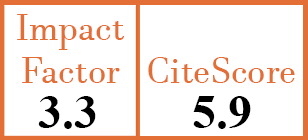Full Papers
Behçet's disease beyond the criteria: insights from a tertiary centre in Turkey
B. Firlatan Yazgan1, E.A. Sahin Mavi2, G.S. Kart Bayram3, B. Bulat4, M. Ekici5, E. Unaldi6, G. Sandal Uzun7, G. Ayan8, Z. Ozsoy9, S.A. Germe10, B. Farisogullari11, E. Duran12, G.K. Yardimci13, E.C. Bolek14, E. Bilgin15, B. Armagan16, A. Sari17, A. Erden18, L. Kilic19, B. Kisacik20, Y. Maras21, I. Dogan22, O. Karadag23, A. Akdogan24, S. Apras Bilgen25, S. Kiraz26, A.I. Ertenli27, U. Kalyoncu28
- Division of Rheumatology, Department of Internal Medicine, Hacettepe University School of Medicine, Hacettepe University Vasculitis Research Centre, Ankara, Turkey. busra.firlatan@gmail.com, busrafirlatan@hacettepe.edu.tr
- Department of Internal Medicine, Hacettepe University School of Medicine, Ankara, Turkey.
- Division of Rheumatology, Department of Internal Medicine, Hacettepe University School of Medicine, Hacettepe University Vasculitis Research Centre, Ankara, Turkey.
- Division of Rheumatology, Department of Internal Medicine, Hacettepe University School of Medicine, Hacettepe University Vasculitis Research Centre, Ankara, Turkey.
- Division of Rheumatology, Department of Internal Medicine, Hacettepe University School of Medicine, Hacettepe University Vasculitis Research Centre, Ankara, Turkey.
- Division of Rheumatology, Department of Internal Medicine, Hacettepe University School of Medicine, Hacettepe University Vasculitis Research Centre, Ankara, Turkey.
- Division of Rheumatology, Department of Internal Medicine, Hacettepe University School of Medicine, Hacettepe University Vasculitis Research Centre, Ankara, Turkey.
- Division of Rheumatology, Department of Internal Medicine, Hacettepe University School of Medicine, Hacettepe University Vasculitis Research Centre, Ankara, Turkey.
- Division of Rheumatology, Department of Internal Medicine, Hacettepe University School of Medicine, Hacettepe University Vasculitis Research Centre, Ankara, Turkey.
- Division of Rheumatology, Department of Internal Medicine, Hacettepe University School of Medicine, Hacettepe University Vasculitis Research Centre, Ankara, Turkey.
- Division of Rheumatology, Department of Internal Medicine, Hacettepe University School of Medicine, Hacettepe University Vasculitis Research Centre, Ankara, Turkey.
- Division of Rheumatology, Department of Internal Medicine, Hacettepe University School of Medicine, Hacettepe University Vasculitis Research Centre, Ankara, Turkey.
- Division of Rheumatology, Department of Internal Medicine, Hacettepe University School of Medicine, Hacettepe University Vasculitis Research Centre, Ankara, Turkey.
- Division of Rheumatology, Department of Internal Medicine, Hacettepe University School of Medicine, Hacettepe University Vasculitis Research Centre, Ankara, Turkey.
- Division of Rheumatology, Department of Internal Medicine, Hacettepe University School of Medicine, Hacettepe University Vasculitis Research Centre, Ankara, Turkey.
- Division of Rheumatology, Department of Internal Medicine, Hacettepe University School of Medicine, Hacettepe University Vasculitis Research Centre, Ankara, Turkey.
- Division of Rheumatology, Department of Internal Medicine, Hacettepe University School of Medicine, Hacettepe University Vasculitis Research Centre, Ankara, Turkey.
- Division of Rheumatology, Department of Internal Medicine, Hacettepe University School of Medicine, Hacettepe University Vasculitis Research Centre, Ankara, Turkey.
- Division of Rheumatology, Department of Internal Medicine, Hacettepe University School of Medicine, Hacettepe University Vasculitis Research Centre, Ankara, Turkey.
- Division of Rheumatology, Department of Internal Medicine, Hacettepe University School of Medicine, Hacettepe University Vasculitis Research Centre, Ankara, Turkey.
- Division of Rheumatology, Department of Internal Medicine, Hacettepe University School of Medicine, Hacettepe University Vasculitis Research Centre, Ankara, Turkey.
- Division of Rheumatology, Department of Internal Medicine, Hacettepe University School of Medicine, Hacettepe University Vasculitis Research Centre, Ankara, Turkey.
- Division of Rheumatology, Department of Internal Medicine, Hacettepe University School of Medicine, Hacettepe University Vasculitis Research Centre, Ankara, Turkey.
- Division of Rheumatology, Department of Internal Medicine, Hacettepe University School of Medicine, Hacettepe University Vasculitis Research Centre, Ankara, Turkey.
- Division of Rheumatology, Department of Internal Medicine, Hacettepe University School of Medicine, Hacettepe University Vasculitis Research Centre, Ankara, Turkey.
- Division of Rheumatology, Department of Internal Medicine, Hacettepe University School of Medicine, Hacettepe University Vasculitis Research Centre, Ankara, Turkey.
- Division of Rheumatology, Department of Internal Medicine, Hacettepe University School of Medicine, Hacettepe University Vasculitis Research Centre, Ankara, Turkey.
- Division of Rheumatology, Department of Internal Medicine, Hacettepe University School of Medicine, Hacettepe University Vasculitis Research Centre, Ankara, Turkey.
CER18992
2025 Vol.43, N°10
PI 1782, PF 1788
Full Papers
Free to view
(click on article PDF icon to read the article)
PMID: 41066186 [PubMed]
Received: 09/06/2025
Accepted : 25/09/2025
In Press: 06/10/2025
Published: 23/10/2025
Abstract
OBJECTIVES:
There are no pathognomonic findings for diagnosing Behçet’s disease (BD), the diagnosis relying primarily on clinical evaluation. We aimed to assess patients with BD based on two classification criteria the International Study Group (ISG) criteria and the International Criteria for Behçet’s Disease (ICBD), both at diagnosis and throughout the disease, and to explore the characteristics of patients who do not meet the criteria but are clinically diagnosed with BD.
METHODS:
Patients with BD were identified from the Hacettepe University Vasculitis Research Centre database. Paediatric cases and those with incomplete clinical data were not included. Demographics, clinical characteristics, and treatments were assessed. The physician’s clinical judgment determined the gold standard for diagnosis. The patients’ fulfilment of the ISG and ICBD criteria was evaluated at diagnosis and during the follow-up.
RESULTS:
The study included 804 patients with BD (49.8% males). The mean age at diagnosis was 28.9±10.4 years. At diagnosis, 52.6% of patients fulfilled the ISG criteria, and 81.0% met the ICBD criteria. During follow-up, these rates increased to 59.0% and 84.7%, respectively. Significant organ involvement (ocular, vascular, or neurological) was present in 47.9% of patients not meeting ISG criteria and 30.9% of those not meeting ICBD criteria. The use of at least one immunosuppressive agent was 48.5% and 38.2% in these groups, respectively.
CONCLUSIONS:
According to various classification criteria, 15-40% of patients with BD do not meet established classification criteria at any point during follow-up, yet significant organ involvement remains prevalent. These findings highlight the limitations of strict criteria-based diagnosis and underscore the importance of clinical expertise in recognising and managing BD.


